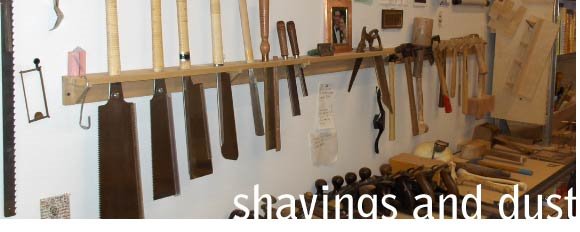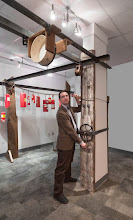mo
st people that make furniture know who David Pye was. He was a Professor of Furniture Design at the Royal College of Art from 1948 to 1973, and in 1968 he published "The Nature and Art of Workmanship," which is still one of the key treatises addressing what we call "workmanship," or craft. I was turned on to the book by
Craig Vandall Stevens, who told me that it was the single most important book in his life and that it was very important that I read it. With that kind of endorsement, how could I not check it out?
 |
| Photo: Phillip Sayer/Crafts Council |
The discussion in the book is primarily about the place of machines in the making process, and their appropriateness given the desired outcome. Pye coined the terms (and I feel a need to acknowledge the implicit sexism contained in the word "workmanship." I will be using that word in this essay only because it is the word that Pye used) "workmanship of risk" (a methodology of making that requires a high level of understanding and craft on the part of the maker, and that can be at any time destroyed by the work due to inattention or callowness) and the "workmanship of certainty" (a methodology that is automated to the point that inattention by the worker has a minimal effect on the outcome of the process). It is important to note that this does not necessarily have anything to do with the machinery used, that depending on the context the machinery associated with workmanship of risk can also be used in a piece at the other end of the spectrum. Pye also points out that there are different levels of workmanship that are appropriate and that this appropriateness is also contextual. It would not make sense to apply the type of precision required to make engine parts to the practice of splitting fence rails, for example. Both endeavors require precision (just ask Abe Lincoln about fence rails), but the type of precision that is appropriate for one is not appropriate for the other.
 |
| Photo: David Pye/ Crafts Council |
This is all an extremely ham-handed explanation and distillation of this book. I suggest you read it for yourself, it is life-changing. It was for me, anyway. What I wanted to write about here, though, was not necessarily that discussion (although one could argue that a great deal of this blog is focused on that discussion), but Pye's woodworking (above, pictured in his shop).
And this is the kind of work that he produced and was known for. He carved these bowls using a nineteenth century tool (I can't seem to find a photo of one on the internet, surprisingly) that made these beautiful gouges that radiate from the center and can be modulated in really breathtaking ways. There are a couple of his bowls in the foreground of the photo above as well. Not all of them are that big, of course, and he experimented widely with the shapes as well, but it is that interior texture that knocks me out. Ever since I first read the book that texture has stuck in my head. Recently I decided to do something about it.
I have had a couple of pieces of long-leaf pine kicking around the shop for a couple of years that are off-cuts from the end of some floor joists from a building on the campus of Trinity College. They are about a foot square, and extremely hard, and they seemed like good candidates for bowldom. The tool that Pye used to make his bowls left that signature tool mark, those radiating lines that start in the center and get wider as they get closer to the edge. I wanted to replicate that mark, and it was important to me that it be the tool that made the mark, that somehow inherent in the making of the object that mark was created. It also seemed to me that this would be a good excuse for me to familiarise myself with our CNC technology and to learn to use a new tool, the drafting program Rhino. Below are some process shots.
 |
| This is the raw material You can see the triangle-shaped area where the surface of the wood did not oxidise because it was set into the wall of the building. |
 |
| This is the file in Rhino, which is the drafting program we use here. |
 |
| I started by surfacing the material and getting all the sides square to each other and the bottom of the piece |
 |
| This is the material on the CNC router table. |
 |
| The machine started by surfacing the top of the blank. |
 |
| The machine starts the way a carver would, by removing the bulk of the material quickly and roughly. |
 |
| Lastly it takes a series of finishing passes. I was able to experiment with different settings to find a tool mark that was pleasing. You can see the scallops that reference the bowls that Pye made. |
Those of you that work with wood will know about the heightened feelings surrounding CNC technology. CNC stands for Computer Numeric Control, which is to say that a computer tells the cutting head where and in what direction and how deep to make a cut in the material. A lot of people that work with wood say that this type of technology is the death of craft (well, of Craft), that it means that anyone can make fancy wood objects, that it devalues the work of people who do not use this technology and that it should be eschewed at all cost. Other people are saying that it is a tool like any other and that it merely needs to be treated like a table saw, a tool that can help achieve a desired goal, and that the object itself is not inherently bad.
I tend to fall somewhere in between these two points of view. Philosophically, this technology is no different from a table saw. It is motorised and can be used to create a very high degree of precision. It requires thoughtful attention to make it do what the user wants it to do, and in the hands of a less skilled worker it can be worse than useless. It makes repeating an operation easy and easy to do in a way that the finished product is identical every time. It (like a table saw) is a tool that gives form nicely to "workmanship of certainty." So why does it feel so different to me?
In no small part it probably feels different because it has become popular and readily available in my lifetime. The table saw was invented in the 1850's by a Shaker woman, it has been around as long as anyone I know can remember. When I started making things professionally, the table saw was already an integral part of the wood shop. I have never seen a professional shop without one. On the other hand, I had not even seen a CNC mill until I was in my mid twenties, and had been making things for a while. So there is that.

I am happy with the finished bowl. I feel like it is a craft object. I spent as much or more time setting up the file and then the machine as I ever did to mill and cut the wood for the table that the rest of this particular long-leaf pine became. I did a lot of thinking about proportion and line and form, as much as I would do if I were carving this bowl by hand. And the bowl sits on our dining table (the top of which I planed by hand in a very laborious way) and every night I enjoy its presence as we eat.
But for me something is lost in this particular amount of remove between the maker and the material. I am used to my interaction with my material being modulated by a saw handle or the butt of a chisel. I am even used to that interaction being filtered through a power tool, a router or a jigsaw (in fact, that was was a great deal of my interaction with material for the entirety of my life in theater). Having that interaction modulated by a computer screen, on the other hand, feels too distant for me. I do not think that having that amount of remove makes for a finished object of less craft or even that the finished object has less emotional resonance. For me, in my making process, it is important for me to have a specific relationship with my material, one that is not modulated through a computer.
 |
| Detail of the tool marks radiating from the center |
This may change over time. It probably will. But as I think about my growth and about my making that is where I sit for the moment.













No comments:
Post a Comment